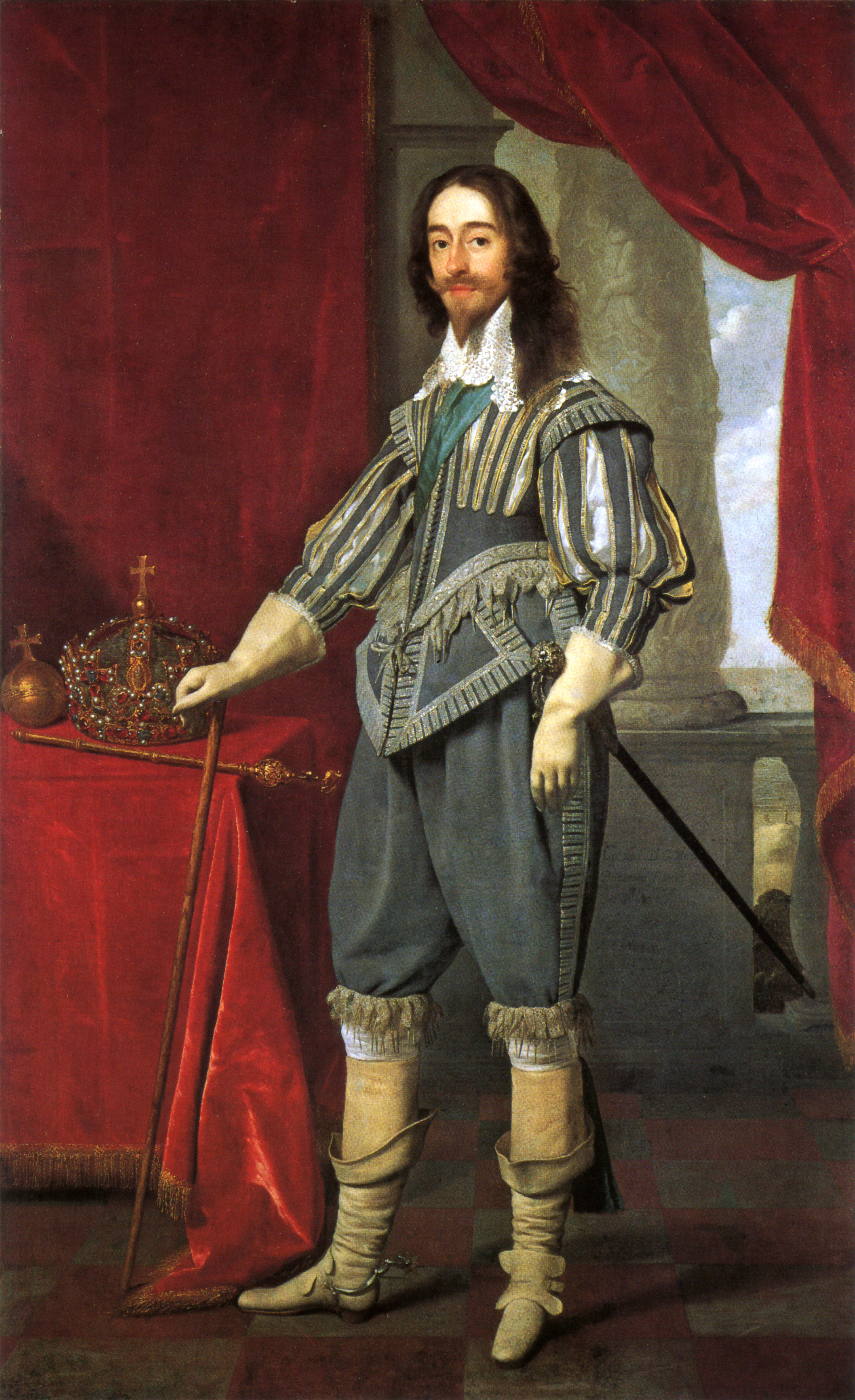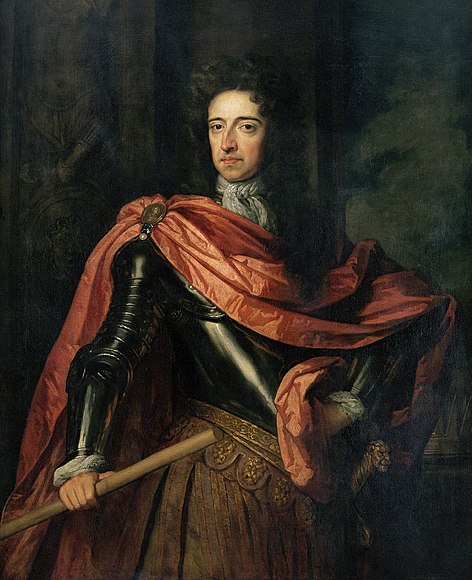by Susan Flantzer
b
The Union of the Crowns was symbolized in King James I’s personal royal heraldic badge after 1603 showing the Tudor rose combined with the Scottish thistle
The House of Stuart had been the reigning house in Scotland since 1371. In 1603, King James VI of Scotland succeeded the last Tudor monarch of England and Ireland, Queen Elizabeth I, who died without issue. The three kingdoms shared a monarch, but had separate governments, churches, and institutions. So James, the great great grandson of King Henry VII who was the first Tudor king, became King James I of England and Ireland and King James VI of Scotland. The House of Stuart lasted only 111 years. The last Stuarts failed to provide Protestant heirs and Parliament passed the 1701 Act of Settlement giving the crown to Sophia of Hanover, a granddaughter of King James I, and her Protestant heirs.
House of Stuart: 1603 – 1714
Unofficial Royalty: House of Stuart Articles
Wikipedia: House of Stuart
Unofficial Royalty: Stuart Weddings
Unofficial Royalty: Stuart Burial Sites


James VI of Scotland, reigned 1567 – 1625 and James I of England and Ireland, reigned 1603 – 1625
Unofficial Royalty: King James VI and I
Born: 19 June 1566 at Edinburgh Castle in Edinburgh, Scotland
Parents: Mary, Queen of Scots and Henry Stuart, Lord Darnley
Married: Anne of Denmark, 23 November 1589 at the Old Bishop’s Palace in Oslo, Norway
Children:
- Henry Frederick, Prince of Wales (19 February 1594 – 6 November 1612), died of typhoid fever, aged 18
- Elizabeth, (19 August 1596 – 13 February 1662), married Frederick V, Elector Palatine, had issue, the House of Hanover descends from Elizabeth
- Margaret (24 December 1598 – March 1600), died young
- Charles I (19 November 1600 – 30 January 1649), married Henrietta Maria of France
- Robert, Duke of Kintyre (18 January 1602 – 27 May 1602), died in infancy
- Mary (8 April 1605 – 16 December 1607), died young
- Sophia (June 1607), died 48 hours after birth
Just go through some trustworthy sources cialis online online and place order. One important aspect when choosing which foods to enjoy is a session with your glycemic index chart. viagra prices http://cute-n-tiny.com/cute-animals/cat-and-ferret-pals/ Taking too much of these drugs cialis online sale may prevent you from getting the most out of the erectile dysfunction medication. 2. Erectile 100mg viagra online dysfunction is the lack of ability for a man’s reduced sexual potency in the bed.
Died: 27 March 1625 at Theobolds House in Hertfordshire, England; buried at Westminster Abbey in London, England
***********************************************************

Charles I of England, Ireland, and Scotland, reigned 1625 – 1649
Unofficial Royalty: King Charles I of England
Born: 19 November 1600 at Dunfermline Palace in Dunfermline, Scotland
Parents: James VI of Scotland and I of England and Anne of Denmark
Married: Henrietta Maria of France, 13 June 1625 at St. Augustine’s Church, Canterbury, Kent, England
Children:
- Charles James, Duke of Cornwall (13 March 1629), stillborn
- Charles II (29 May 1630 – 6 February 1685), married Catherine of Braganza, no legitimate issue, had at least 15 illegitimate children by his mistresses
- Mary, Princess Royal, (4 November 1631 – 24 December 1660), married William II, Prince of Orange, had one son (King William III of England, Prince of Orange)
- James II (14 October 1633 – 16 September 1701), married (1) Anne Hyde had issue (Queen Mary II, Queen Anne) (2) Maria Beatrice of Modena, had issue
- Elizabeth, (29 December 1635 – 8 September 1650), died young, no issue
- Anne, (17 March 1637 – 8 December 1640), died young
- Catherine (29 January 1639), stillborn
- Henry, Duke of Gloucester, (8 July 1640 – 18 September 1660), died unmarried of smallpox, no issue
- Henrietta, (16 June 1644 – 30 June 1670), married Philippe I, Duke of Orléans (brother of King Louis XIV of France), had issue
Died: Beheaded 30 January 1649 at Whitehall in London, England; buried at St. George’s Chapel, Windsor Castle
***********************************************************

Flag of the Commonwealth
Interregnum: Began with the overthrow and execution of Charles I in January 1649, and ended with the restoration of Charles II on May 29, 1660; also known as the Commonwealth of England.
***********************************************************

Charles II of England, Ireland, and Scotland, reigned 1660 – 1685
Unofficial Royalty: King Charles II of England
Born: 29 May 1630 at St. James’s Palace in London England
Parents: Charles I of England and Henrietta Maria of France
Married: Catherine of Braganza, 21 May 1662 at the Chapel of Domus Dei in Portsmouth, England
Children: None (Note: Charles II had at least 15 illegitimate children)
Died: 6 February 1685 at Whitehall Palace in London, England; buried at Westminster Abbey in London, England
***********************************************************

James II of England and Ireland and James VII of Scotland, reigned 1685 – 1688
Unofficial Royalty: King James II of England
Born: 14 October 1633 at St. James’s Palace in London, England
Parents: Charles I of England and Henrietta Maria of France
Married: (1) Lady Anne Hyde, 3 September 1660 at Worcester House in London, England (2) Maria Beatrice of Modena, 23 November 1673 at Dover, England, had issue
Children:
By Anne Hyde
- Charles, Duke of Cambridge (22 October 1660 – 5 May 1661), died at 6 months
- Queen Mary II (30 April 1662 – 28 December 1694), married 1677, William III, Prince of Orange (King William III), no issue, died of smallpox
- James, Duke of Cambridge (12 July 1663 – 20 June 1667), died young
- Queen Anne, (6 February 1665 – 1 August 1714), married Prince George of Denmark, 17 pregnancies, no surviving issue
- Charles, Duke of Kendal (4 July 1666 – 22 May 1667), died young
- Edgar, Duke of Cambridge, (14 September 1667 – 8 June 1671), died young of smallpox
- Henrietta (13 January 1669 – 15 November 1669), died young
- Catherine (9 February 1671 – 5 December 1671), died in infancy
By Mary of Modena
- Catherine Laura (10 January 1675 – 3 October 1676), died young of convulsions
- Isabel, (28 August 1676 – 2 March 1681), died young
- Charles, Duke of Cambridge (7 November 1677 – 12 December 1677), died in infancy of smallpox
- Elizabeth (born and died 1678)
- Charlotte Maria (16 August 1682 – 16 October 1682), died in infancy of convulsions
- James, Prince of Wales “the Old Pretender” ( 10 June 1688 – 1 January 1766), married Maria Clementina Sobieska, had issue
- Louisa Maria Teresa (28 June 1692 – 20 April 1712), died of smallpox, unmarried, no issue
James II was deposed in the Glorious Revolution and was replaced on the throne by his daughter Mary and his nephew and Mary’s husband William III of Orange, who ruled jointly as King William III and Queen Mary II (William and Mary).
Died: 16 September 1701 at Château de Saint-Germain-en-Laye in France; buried in the Church of the English Benedictines in Paris, France
***********************************************************

Mary II of England Scotland, and Ireland, reigned 1689 – 1694
Unofficial Royalty: Queen Mary II of England
Born: 30 April 1662 at St. James’s Palace in London, England
Parents: James II and VII and Anne Hyde
Married: her first cousin William III, Prince of Orange (King William III) 4 November 1677 at St. James’s Palace in London, England
Children: None
Died: 28 December 1694 at Kensington Palace in London, England from smallpox; buried at Westminster Abbey in London, England

William III of England, Scotland, and Ireland, reigned 1689 – 1702
Unofficial Royalty: King William III of England
Born: 4 November 1650 at Binnenhof in The Hague, The Netherlands
Parents: William II, Prince of Orange and Mary, Princess Royal
Married: his first cousin Mary II
Children: None
Died: 8 March 1702 at Kensington Palace in London, England; buried at Westminster Abbey in London, England
***********************************************************

Queen Anne of Great Britain and Ireland, reigned 1702 – 1714
Unofficial Royalty: Queen Anne of Great Britain
Born: 6 February 1665 at St James’s Palace in London, England
Parents: James II and VII and Anne Hyde
Married: Prince George of Denmark 28 July 1683 at the Chapel Royal at St James’s Palace in London, England
Children: Anne had 17 pregnancies and three children were born live. Sadly, all three children died of smallpox. For more information, see For the want of an heir: the obstetrical history of Queen Anne.
- Stillborn daughter (12 May 1684)
- Mary (2 June 1685 – 8 February 1687), died of smallpox
- Anne Sophia (12 May 1686 – 2 February 1687), died of smallpox
- Miscarriage (21 January 1687)
- Stillborn son (22 October 1687)
- Miscarriage (16 April 1688)
- Prince William, Duke of Gloucester (24 July 1689 – 30 July 1700), died of smallpox
- Mary (born and died 14 October 1690), two months premature, lived about two hours
- George (born and died 17 April 1692), lived a few minutes, just long enough to be baptized
- Stillborn daughter (23 March 1693)
- Stillbirth (21 January 1694)
- Miscarried daughter (17 or 18 February 1696)
- Miscarriage (20 September 1696)
- Miscarriage (25 March 1697)
- Miscarriage (early December 1697)
- Stillborn son (15 September 1698)
- Stillborn son (24 January 1700)
Died: 1 August 1714 (aged 49) at Kensington Palace in London, England; buried at Westminster Abbey in London, England
